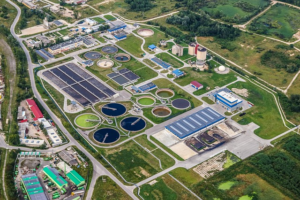
The University of Kansas, in conjunction with the City of Lawrence, Kansas, has been investigating a fascinating approach to reducing nitrogen and phosphorus from wastewater.
It’s a process, really, that occurs in nature, with a minimum of artificial intervention. Simply put: still water containing an abundance of “nutrients” tends to produce a proliferation of green algae.
A Most Interesting Approach
Why not take advantage of that fact? And so, they have. In their September 2013 Issue, Treatment Plant Operator (TPO) magazine included a well-written piece by author Doug Day that greatly intrigued me.
Not long ago, I was employed as a Wastewater Operator, Level III at the local Nelson County, Virginia treatment plant. I am a retired chemist. I had rejected a career in chemical engineering, because I really enjoy processes of Nature, rather than the processes of Man.
Nitrogen and Phosphorus and Potassium
Even those of us not farmers realize that most fertilizers available on the market feature three main nutrients: nitrogen, phosphorus, and potassium, or N-P-K¹. In wastewater treatment plants, potassium is not a common problem, but nitrogen and phosphorus are. Government agencies strictly regulate how much of these pollutants can be released from the plant into bodies of water.
Nitrogen promotes the development of green vegetation, including algae. Ordinarily, algae are limited in waterways because of a lack of phosphorus. Phosphorus is present in DNA and is important in the formation of cell membranes.
Both nitrogen and phosphorus exist in abundance in raw wastewater. If these substances are used up in forming algae, the moisture remaining is depleted and may be safe to release into the environment! Therefore, an immediate goal of the plant operator is to grow algae!
What to Do with the Algae?
But what can be done with the algae? KU researchers have also investigated turning the algae into a useful source of energy, namely biodiesel. Most of us are at least passingly aware of the move to use alcohol in gasoline. There is another movement to provide energy in the form of artificial man-made diesel (talk about an oxymoron!) or “natural” diesel—biodiesel.
Yes, Kansas University researchers are having at least a measure of success in this area as well. To quote TPO magazine, “The bio-crude has very similar properties to crude oil that comes out of the ground.”- Belinda Sturm.
1 K is the chemical symbol for potassium, taken from the Latin, kalium, referring to potassium’s alkalinity.
Note: You might also enjoy Algae – When Life Hands You a Lemon
References:
- University of Minnesota Extension Service: Why Does My Lake Have Algae?
- Linus Pauling Institute: Micronutrient Information Center: Phosphorus
- City of Lawrence Kansas: Biofuel from Algae
- Research.gov: Sparking the Algae Harvest

Interesting idea, use nature to help instead of trying unsuccessfuly to beat it!